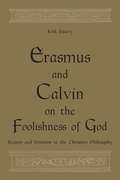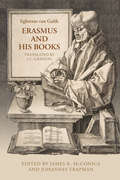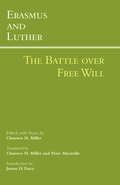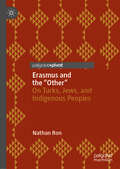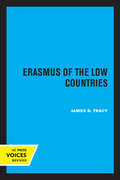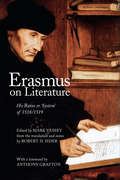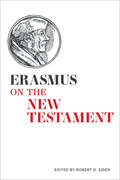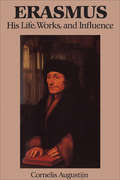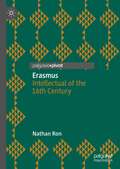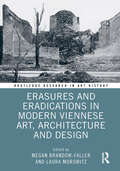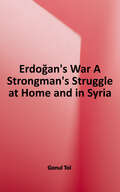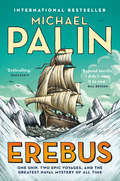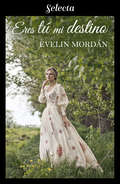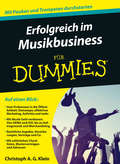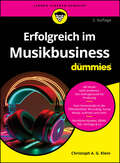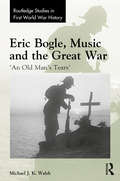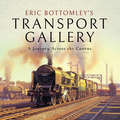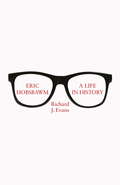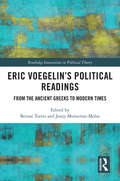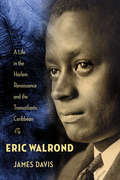- Table View
- List View
Erasmus and Calvin on the Foolishness of God: Reason and Emotion in the Christian Philosophy
by Kirk EssaryWhat did Paul mean when he wrote that the foolishness of God is wiser than human wisdom? Through close analysis of the sixteenth-century reception of Paul's discourses of folly, this book examines the role of the New Testament in the development of what Erasmus and John Calvin refer to as the “Christian philosophy.” Erasmus and Calvin on the Foolishness of God reveals the importance of Pauline rhetoric in the development of humanist critiques of scholasticism while charting the formation of a specifically affective approach to religious epistemology and theological method. As the first book-length examination of Calvin's indebtedness to Erasmus, which also considers the participation of Bullinger, Pellikan, and Melanchthon in an Erasmian exegetical milieu, it is a case study in the complicated cross-confessional exchange of ideas in the sixteenth century. Kirk Essary examines assumptions about the very nature of theology in the sixteenth century, how it was understood by leading humanist reformers, and how ideas about philosophy and rhetoric were received, appropriated, and shared in a complex intellectual and religious context.
Erasmus and His Books (Erasmus Studies)
by J. C. Grayson Egbertus Van Gulik James K. McConica J. TrapmanWhat became of Erasmus’ books? The most famous scholar of his day died in peaceful prosperity and in the company of celebrated and responsible friends. His zeal for useful books was insatiable. Indeed, he had taken care to insure that after his death they would pass to an appreciative noble owner, yet after his death their fate was unknown. Erasmus and His Books provides the most comprehensive evidence available about the books of Erasmus of Rotterdam – the books he owned and his attitude towards them, when and how he acquired them, how he housed, used, and cared for them, and how, from time to time, he disposed of them. Part 1 details the formation, growth, scope, and arrangement of Erasmus’ library and opens the door to a new understanding of the more intimate side of his daily life as a scholar at home with his books, friends, publishers, and booksellers. Part 2 presents a carefully annotated catalogue, the Versandliste, of the more than 400 books in Erasmus’ possession at one point. Drawing upon his command of bibliographical data and his extensive knowledge of Erasmus’ correspondence and related records Egbertus van Gulik proposes as precise an identification of each of the titles as the evidence will allow. Van Gulik’s insightful discoveries tell us what can be known of books in Erasmus’ working library and how he used them and will be of interest to students of the northern Renaissance, the history of the book, and the history of learning.
Erasmus and Luther: The Battle over Free Will
by Clarence H. Miller James D. Tracy Peter MacardleThis compilation of writings from Erasmus and Luther's great debate--over free will and grace, and their respective efficacy for salvation--offers a fuller representation of the disputants' main arguments than has ever been available in a single volume in English. Included are key, corresponding selections from not only Erasmus' conciliatory A Discussion or Discourse concerning Free Will and Luther's forceful and fully argued rebuttal, but--with the battle now joined--from Erasmus' own forceful and fully argued rebuttal of Luther. Students of Reformation theology, Christian humanism, and sixteenth-century rhetoric will find here the key to a wider appreciation of one of early modern Christianity's most illuminating and disputed controversies.
Erasmus and Voltaire
by Ricardo J. QuinonesDespite comparisons between Erasmus and Voltaire having become common-place in the course of the nineteenth century, this is the first full study to bring them together in their careers, their works, and their historic afterlives. Each was a force for change in his time and thus ranks among the masters of modern liberalism. Beginning with the continuities between the Renaissance and the Enlightenment, award-winning scholar Ricardo J. Quinones joins Erasmus and Voltaire as voices of moderation and reason that remain capable of addressing the philosophical crises of twentieth-century thought.A companion piece to Dualisms, Quinones' 2007 book, Erasmus and Voltaire differs in method: where its predecessor looked to inveterate, unyielding differences, this new work looks to similarities. In delving beneath the obvious differences between these two intellectual giants, Quinones uncovers the great practical and spiritual vocations that unite them.
Erasmus and the “Other”: On Turks, Jews, and Indigenous Peoples
by Nathan RonThis book investigates how Erasmus viewed non-Christians and different races, including Muslims, Jews, the indigenous people of the Americas, and Africans. Nathan Ron argues that Erasmus was devoted to Christian Eurocentrism and not as tolerant as he is often portrayed. Erasmus’ thought is situated vis-à-vis the thought of contemporaries such as the cosmographer and humanist Aeneas Sylvius Piccolomini who became Pope Pius II; the philosopher, scholar, and Cardinal, Nicholas of Cusa; and the Dominican missionary and famous defender of the Native Americans, Bartolomé Las Casas. Additionally, the relatively moderate attitude toward Islam which was demonstrated by Michael Servetus, Sebastian Franck, and Sebastian Castellio is analyzed in comparison with Erasmus’ harsh attitude toward Islam/Turks.
Erasmus of Rotterdam
by Christine Christ von-WedelThis book provides the first analysis of the development of Erasmus' historical methodology and its impact on Roman Catholic and Protestant theologians. Combining a biography of Erasmus with the larger theological debates and the intellectual history of his time, Christine Christ-von Wedel reveals many of previously unexplored influences on Erasmus, as well as his influences on his contemporaries.Erasmus of Rotterdam is a revised and considerably enlarged translation of Christ-von Wedel's well-received 2003 study, originally published in German. Observing the influence of classical, biblical, patristic, scholastic, and late medieval vernacular and popular sources on Erasmus' writing, the author provides comparisons with theologians Agrippa, Lefèvre d'Étaples, Eck, Luther, and Zwingli to demonstrate not only the singularity of Erasmus' intellect, but also the enormous impact he had on the Reformation. The result is a lively picture of the man and his time, in which Erasmus emerges as both a devout Christian and a critical seeker of truth who conceded the ambiguities that he could not resolve.
Erasmus of the Low Countries
by James D. TracyFew historical figures have been more important in modeling the ideal of impartial critical scholarship than Erasmus of Rotterdam (1469-1536). Yet his critical scholarship, though beholden to no one, was not dispassionate. James Tracy shows how Erasmus the scholar sought through his writings to promote the moral and religious renewal of Christian society. Tracy finds the genesis of the humanist's notion of a "Christian republic" of pious and learned individuals in his "Burgundian," or Low Countries, roots. Erasmus's vision of reform, Tracy argues, sprung from a humanist tradition focusing on the importance of teaching (doctrina), a tradition from which Erasmus departed in his optimism about human nature and his deep suspicion of the powers that be. Amid the storms of Reformation controversy, he pruned back the "dissimulation" by which he had thought to convey different meanings to different readers, yet in the end he could not control the way his words were read. If Erasmus's scholarly ideal carries an enduring fascination, so too does his dilemma as a man of circumspection who would also be a reformer. This title is part of UC Press's Voices Revived program, which commemorates University of California Press’s mission to seek out and cultivate the brightest minds and give them voice, reach, and impact. Drawing on a backlist dating to 1893, Voices Revived makes high-quality, peer-reviewed scholarship accessible once again using print-on-demand technology. This title was originally published in 1966.
Erasmus on Literature: His Ratio or ‘System’ of 1518/1519 (Erasmus Studies)
by Robert D. SiderNone of the works included among Erasmus’ ‘Literary and Educational Writings’ in the Collected Works of Erasmus captures his most adventurous thinking about how texts signify in – and thereby make or remake – worlds of thought, feeling, and action. The one that comes closest to doing so, the Ratio verae theologiae (‘A System of True Theology’), was first published separately in 1518 and 1519, then appeared in the preliminaries to the New Testament in Erasmus’ (revised) 1519 edition. This handy Ratio or compendious ‘System’ gave advice on how to interpret complex texts and develop persuasive arguments based upon them. Its lessons were applied to the canonical Scriptures as source, and to everyday Christian theology as target discourse. They unfold in response to the special difficulties and incitements of the biblical text in Latin and Greek, within a framework provided by classical grammar and rhetoric, adjusted to the examples of the Church Fathers as exemplary interpreters of the Bible. At every turn, the Ratio reveals the instincts and intuitions of an exceptional theorist and practitioner of the cognitive, social, and political arts of written language. This student edition, the first of its kind in any language, is based on the translation and notes by Robert D. Sider in the Collected Works of Erasmus Volume 41 . It is designed to make it easier to estimate the long-term value of this particular work and of Erasmus’ works more generally, and to allow for a multidisciplinary understanding of the lives of human beings as symbol-using creatures in worlds constructed partly by texts.
Erasmus on the New Testament: New Testament Scholarship: Paraphrase On The Acts Of The Apostles (Erasmus Studies #50)
by Robert SiderWhen Erasmus, at Cambridge in 1512, began to mark up his copy of the Vulgate Bible with a few alternative Latin translations and a biting comment here and there in Latin, he could not have guessed that his work would grow over the next twenty-three years into the twenty volumes currently being produced as annotated translations in The Collected Works of Erasmus. Paraphrases vastly expanded the text of the New Testament books, and brought dynamic and controversial interpretations to the traditional reading of the Latin texts. A new translation based on the Greek text, the first ever to be published by a printing firm, became the basis for ever-expanding notes that explained the Greek, measured the contemporary church against the truth revealed by the Greek, taunted critics and opponents, and revealed the mind of a humanist at work on the Scriptures. The sheer vastness of the work that finally accumulated is almost beyond the reach of a single individual. By excerpts chosen over the entire extent of Erasmus’ New Testament work, this book hopes to reduce that immensity to manageable size, and bring the rich, virtually unlimited treasure of the Erasmian mind on the Scriptures within the comfortable reach of every interested individual.
Erasmus: His Life, Works, and Influence
by Cornelis Augustijn J. C. GraysonErasmus: His Life, Works, and Influence is a comprehensive introduction to Erasmus's life, works, and thoughts. It integrates the best scholarship of the past twenty years and will appeal to undergraduates in all areas of cultural history as well as Erasmus specialists.
Erasmus: Intellectual of the 16th Century
by Nathan RonThis book is a sequel to Nathan Ron's Erasmus and the “Other.” Should we consider Erasmus an involved or public intellectual alongside figures such as Machiavelli, Milton, Locke, Voltaire, and Montesquieu? Was Erasmus really an independent intellectual? In Ron's estimation, Erasmus did not fully live up to his professed principles of Christian peace. Despite the anti-war preaching so eminent in his writings, he made no stand against the warlike and expansionist foreign policies of specific European kings of his era, and even praised the glory won by Francis I on the battlefield of Marignano (1515). Furthermore, in the face of Henry VIII’s execution of his beloved Thomas More and John Fisher, and the atrocities committed by the Spanish against indigenous peoples in the New World, Erasmus preferred self-censorship to expressions of protest or criticism and did not step forward to reproach kings of their misdeeds or crimes.
Erasures and Eradications in Modern Viennese Art, Architecture and Design (Routledge Research in Art History)
by Laura Morowitz Megan Brandow-FallerErasures and Eradications in Modern Viennese Art, Architecture and Design challenges the received narrative on the artists, exhibitions, and interpretations of Viennese Modernism. The book centers on three main erasures—the erasure of Jewish artists and critics; erasures relating to gender and sexual identification; and erasures of other marginalized figures and movements. Restoring missing elements to the story of the visual arts in early twentieth-century Vienna, authors investigate issues of gender, race, ethnic and sexual identity, and political affiliation. Both well-studied artists and organizations—such as the Secession and the Austrian Werkbund, and iconic figures such as Klimt and Hoffmann—are explored, as are lesser known figures and movements. The book’s thought-provoking chapters expand the chronological contours and canon of artists surrounding Viennese Modernism to offer original, nuanced, and rich readings of individual works, while offering a more diverse portrait of the period from 1890, through World War II and into the present. The book will be of interest to scholars working in art history, history, design history, architectural history, and European studies.
Erdoğan's War: A Strongman's Struggle at Home and in Syria
by Gonul TolRecep Tayyip Erdoğan, Turkey's pugnacious president, is now the country's longest-serving leader. On his way to the top, he has fought many wars. This book tells the story of those battles against domestic enemies through the lens of the Syrian conflict, which has become part and parcel of Erdoğan's fight to remain in power. Turkey expert Gönül Tol traces Erdoğan's ideological evolution from a conservative democrat to an Islamist and a Turkish nationalist, and explores how this progression has come to shape his Syria policy, changing the course of the war. She paints a vivid picture of the president's constantly shifting strategy to consolidate his rule, showing that these shifts have transformed Turkey's role in post-uprising Syria from an advocate of democracy, to a power fanning the flames of civil war, to an occupier. From the first days of Erdoğan's rule through the failed coup against him, via the Kurdish peace process, the Arab uprisings and the refugee crisis, this compelling, authoritative book tells the story of one man's quest to remain in power--tying together the fates of two countries, and changing them both forever.
Erebus: One Ship, Two Epic Voyages, and the Greatest Naval Mystery of All Time
by Michael PalinIntrepid voyager, writer and comedian Michael Palin follows the trail of two expeditions made by the Royal Navy's HMS Erebus to opposite ends of the globe, reliving the voyages and investigating the ship itself, lost on the final Franklin expedition and discovered with the help of Inuit knowledge in 2014.The story of a ship begins after the defeat of Napoleon at Waterloo, when Great Britain had more bomb ships than it had enemies. The solid, reinforced hulls of HMS Erebus, and another bomb ship, HMS Terror, made them suitable for discovering what lay at the coldest ends of the earth. In 1839, Erebus was chosen as the flagship of an expedition to penetrate south to explore Antarctica. Under the leadership of the charismatic James Clark Ross, she and HMS Terror sailed further south than anyone had been before. But Antarctica never captured the national imagination; what the British navy needed now was confirmation of its superiority by making the discovery, once and for all, of a route through the North-West Passage. Chosen to lead the mission was Sir John Franklin, at 59 someone many considered too old for such a hazardous journey. Nevertheless, he and his men confidently sailed away down the Thames in April 1845. Provisioned for three winters in the Arctic, Erebus and Terror and the 129 men of the Franklin expedition were seen heading west by two whalers in late July. No one ever saw them again. Over the years there were many attempts to discover what might have happened--and eventually the first bodies were discovered in shallow graves, confirming that it had been the dreadful fate of the explorers to die of hunger and scurvy as they abandoned the ships in the ice. For generations, the mystery of what had happened to the ships endured. Then, on September 9th, 2014, came the almost unbelievable news: HMS Erebus had been discovered thirty feet below the Arctic waters, by a Parks Canada exploration ship. Palin looks at the Erebus story through the different motives of the two expeditions, one scientific and successful, the other nationalistic and disastrous. He examines the past by means of the extensive historical record and travels in the present day to those places where there is still an echo of Erebus herself, from the dockyard where she was built, to Tasmania where the Antarctic voyage began and the Falkland Islands, then on to the Canadian Arctic, to get a sense of what the conditions must have been like for the starving, stumbling sailors as they abandoned their ships to the ice. And of course the story has a future. It lies ten metres down in the waters of Nunavut's Queen Maud Gulf, where many secrets wait to be revealed.
Erebus: One Ship, Two Epic Voyages, and the Greatest Naval Mystery of All Time
by Michael PalinIntrepid voyager, writer and comedian Michael Palin follows the trail of two expeditions made by the Royal Navy's HMS Erebus to opposite ends of the globe, reliving the voyages and investigating the ship itself, lost on the final Franklin expedition and discovered with the help of Inuit knowledge in 2014.The story of a ship begins after the defeat of Napoleon at Waterloo, when Great Britain had more bomb ships than it had enemies. The solid, reinforced hulls of HMS Erebus, and another bomb ship, HMS Terror, made them suitable for discovering what lay at the coldest ends of the earth. In 1839, Erebus was chosen as the flagship of an expedition to penetrate south to explore Antarctica. Under the leadership of the charismatic James Clark Ross, she and HMS Terror sailed further south than anyone had been before. But Antarctica never captured the national imagination; what the British navy needed now was confirmation of its superiority by making the discovery, once and for all, of a route through the North-West Passage. Chosen to lead the mission was Sir John Franklin, at 59 someone many considered too old for such a hazardous journey. Nevertheless, he and his men confidently sailed away down the Thames in April 1845. Provisioned for three winters in the Arctic, Erebus and Terror and the 129 men of the Franklin expedition were seen heading west by two whalers in late July. No one ever saw them again. Over the years there were many attempts to discover what might have happened--and eventually the first bodies were discovered in shallow graves, confirming that it had been the dreadful fate of the explorers to die of hunger and scurvy as they abandoned the ships in the ice. For generations, the mystery of what had happened to the ships endured. Then, on September 9th, 2014, came the almost unbelievable news: HMS Erebus had been discovered thirty feet below the Arctic waters, by a Parks Canada exploration ship. Palin looks at the Erebus story through the different motives of the two expeditions, one scientific and successful, the other nationalistic and disastrous. He examines the past by means of the extensive historical record and travels in the present day to those places where there is still an echo of Erebus herself, from the dockyard where she was built, to Tasmania where the Antarctic voyage began and the Falkland Islands, then on to the Canadian Arctic, to get a sense of what the conditions must have been like for the starving, stumbling sailors as they abandoned their ships to the ice. And of course the story has a future. It lies ten metres down in the waters of Nunavut's Queen Maud Gulf, where many secrets wait to be revealed.
Eres tú mi destino
by Evelin MordánLa vida puede cambiar en un instante si te enamoras de la persona incorrecta. Prometida durante años con su amigo de la infancia, lady Elizabeth recibe con agrado a su prometido cuando sus negocios finalizan y vuelve para cumplir su deber. Lord Hallet, que ha huido todo lo posible del compromiso, se encuentra con una mujer hermosa que le pertenece. Pero el amor de Elizabeth despierta con quien no debe cuando en su camino vuelve a cruzarse con Alexander Folcher. La enemistad entre dos hermanos y también algunos secretos pondrán la apaciguada vida de la joven en una encrucijada ante el deber y el amor que siente. Una decisión lo cambiará todo y, si no es la correcta, el destino de tres personas estará en juego.
Erfolgreich im Musikbusiness für Dummies
by Christoph A. KleinSie sind Musiker mit Leib und Seele und wollen nun den nächsten Schritt wagen? Ihre Musik soll gehört werden und statt im Proberaum zu versauern, wollen Sie auf die Bühne oder mit Ihren Songs ins Radio? Christoph A. G. Klein zeigt Ihnen, wie es geht: Denn gute Musik zu machen, reicht leider nicht aus. Von GEMA, GVL und Künstlersozialkasse über die rechtlichen Aspekte bis hin zu Marketing, Plattenverträgen und Konzertveranstaltung - Stolpersteine gibt es zur Genüge. Sie erfahren alles über die verschiedenen Akteure im Musikgeschäft, wie Sie effektives Marketing betreiben, was Sie bei Demotapes und Liveauftritten beachten müssen und wie Sie sonst noch mit Musik Geld verdienen können. Dieses Buch ist praxisorientiert und beleuchtet alle wichtigen Aspekte des Musikbusiness. Zahlreiche Checklisten, Musterverträge und wichtige Adressen runden das Buch ab.
Erfolgreich im Musikbusiness für Dummies (Für Dummies)
by Christoph A. KleinSo wird das Showbusiness Ihr Business Tauchen Sie ein in die Welt der Musik und entdecken Sie, wie Sie als leidenschaftlicher Musiker oder Produzent den Sprung auf die große Bühne schaffen! Christoph Klein führt Sie durch den Dschungel von GEMA, GVL und Künstlersozialkasse, wirft einen Blick auf die juristischen Feinheiten und entwirrt den Knoten von Plattenverträgen und Co. In diesem Buch erfahren Sie alles über die wichtigsten Player der Musikindustrie, wie Sie effektives Marketing betreiben und was bei professionellen Aufnahmen und Liveauftritten zu beachten ist. Zahlreiche Checklisten, Musterverträge und hilfreiche Adressen machen es zum unverzichtbaren Begleiter auf Ihren Weg zum Erfolg. Sie erfahren Wie Sie sich auf dem Musikmarkt erfolgreich positionieren Wer im Musikbusiness alles mitwirkt Was Sie bei GEMA und Co beachten sollten Wie Sie Social Media optimal für Ihre Musik einsetzen
Eric Bogle, Music and the Great War: 'An Old Man's Tears' (Routledge Studies in First World War History)
by Michael J. WalshEric Bogle has written many iconic songs that deal with the futility and waste of war. Two of these in particular, ‘And the Band Played Waltzing Matilda’ and ‘No Man’s Land (a.k.a. The Green Fields of France)’, have been recorded numerous times in a dozen or more languages indicating the universality and power of their simple message. Bogle’s other compositions about the First World War give a voice to the voiceless, prominence to the forgotten and personality to the anonymous as they interrogate the human experience, celebrate its spirit and empathise with its suffering. This book examines Eric Bogle’s songs about the Great War within the geographies and socio-cultural contexts in which they were written and consumed. From Anzac Day in Australia and Turkey to the ‘The Troubles’ in Northern Ireland and from small Aboriginal communities in the Coorong to the influence of prime ministers and rock stars on a world stage, we are urged to contemplate the nature and importance of popular culture in shaping contemporary notions of history and national identity. It is entirely appropriate that we do so through the words of an artist who Melody Maker described as ‘the most important songwriter of our time’.
Eric Bottomley's Transport Gallery: A Journey Across the Canvas
by Eric BottomleyThis is Eric Bottomley's second art book, in which he has varied both his transport themes and the mediums in which he works. The majority of paintings are in oils but also included are gouache (watercolor) and pencil sketches. However, some paintings are both gouache and pencil, together known as mixed media.Railways have always been a great passion of Eric's, from trainspotting around the ex-Lancashire & Yorkshire system as a boy, to painting commisions for customers both private and commercial. From his lowly studio in Wimborne, Dorset, where his painting career took off, Eric never envisaged that one day he would witness his paintings being presented to the Duke of Kent, or that he would meet the Duke of Gloucester (a fellow railway enthusiast). In 1979 he joined the Guild of Railway Artists, and later became a full member.Included in this book are all four regions of Britain's railway, but mostly the BR period from 1948, to the end of steam in 1968. Added to this are such scenes as the Trans-Siberian Express in Moscow, The Golfers Express leaving Belfast and preserved diesels in the USA.The sad demise of steam and dereliction of the canals in the 1960s, and the amazing restoration projects over the years, has provided Eric with an enormous scope of subject matter, much of which is captured in this compelling book.
Eric Drummond and his Legacies: The League of Nations and the Beginnings of Global Governance (Understanding Governance)
by John Burley David Macfadyen Michael D. Davies Marilyn Norah CarrThis book shows how the first institution of global governance was conceived and operated. It provides a new assessment of its architect, Eric Drummond, the first Secretary-General of the League of Nations, appointed a century ago. The authors conclude that he stands in the front rank of the 12 men who have occupied the post of Secretary-General of the League or its successor, the UN. Part 1 describes his character and leadership. His influence in shaping the International Civil Service, the ‘beating heart’ of the League, is the subject of Part 2, which also shows how the young staff he appointed responded with imagination and creativity to the political, economic and social problems that followed World War I. Part 3 shows the influence of these early origins on today’s global organizations and the large scale absorption of League policies, programmes, practices and staff into the UN and its Specialized Agencies.
Eric Hobsbawm: A Life in History
by Sir Richard J. Evans FBA, FRSL, FRHisAt the time of his death at the age of 95, Eric Hobsbawm (1917-2012) was the most famous historian in the world. His books were translated into more than fifty languages and he was as well known in Brazil and Italy as he was in Britain and the United States. His writings have had a huge and lasting effect on the practice of history. More than half a century after it appeared, his books remain a staple of university reading lists.He had an extraordinarily long life, with interests covering many countries and many cultures, ranging from poetry to jazz, literature to politics. He experienced life not only as a university teacher but also as a young Communist in the Weimar Republic, a radical student at Cambridge, a political activist, an army conscript, a Soho 'man about town', a Hampstead intellectual, a Cambridge don, an influential journalist, a world traveller, and finally a Grand Old Man of Letters.In A Life in History, Richard Evans tells the story of Hobsbawm as an academic, but also as witness to history itself, and of the twentieth century's major political and intellectual currents. Eric not only wrote and spoke about many of the great issues of his time, but participated in many of them too, from Communist resistance to Hitler to revolution in Cuba, where he acted as an interpreter for Che Guevara. He was a prominent part of the Jazz scene in Soho in the late 1950s and his writings played a pivotal role in the emergence of New Labour in the late 1980s and early 1990s.This, the first biography of Eric Hobsbawm, is far more than a study of a professional historian. It is a study of an era.
Eric Voegelin’s Political Readings: From the Ancient Greeks to Modern Times (Routledge Innovations in Political Theory)
by Bernat Torres and Josep MonserratEric Voegelin’s Political Readings fills a critical void by providing an original approach to studying the work of Eric Voegelin, one of the major political philosophers of the twenty-first century. Across six chapters, experts guide the reader from classical to modern times presenting six political philosophers who have had an impact on the life and philosophical production of Eric Voegelin. Philosophers examined include Plato, Aristotle, Saint Augustine, Hobbes, Weber and Kelsen. Through this innovative structure, the chapters collectively illustrate how Voegelin was an exceptional thinker through his engagement with political philosophers both modern and antique. The plurality of unique, academic perspectives and voices enriches our understanding of Voegelin’s own thought while also encouraging a re-think of ancient and modern thinkers, and the transformation and continuity between these. Designed for students and scholars alike, Eric Voegelin’s Political Readings will appeal to all those with an interest in Voegelin as well as readers familiar with classical and modern political philosophers.
Eric Walrond: A Life in the Harlem Renaissance and the Transatlantic Caribbean
by James DavisThe first biography of a fascinating Caribbean-born writer, unraveling the mystery behind his disappearance from New York at the end of the Harlem Renaissance and recognizing his contribution to the New Negro movement beyond Harlem.
